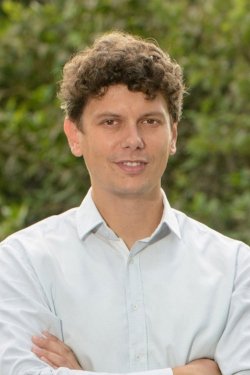Rafal Klajn
2021 Israel Award Winner — Faculty

Current Position:
Associate Professor; Head, Helen and Martin Kimmel Center for Molecular Design
Institution:
Weizmann Institute of Science
Discipline:
Chemistry

Current Position:
Associate Professor; Head, Helen and Martin Kimmel Center for Molecular Design
Institution:
Weizmann Institute of Science
Discipline:
Chemistry
Recognized for: Harnessing the power of colloidal and organic chemistry to create dynamic nanomaterials that react to external stimuli, and designing nanostructures to probe chemical reactions that take place in confined spaces. Through careful design of intricate supramolecular and nanoparticulate architectures, his work aims to create ‘life-like’ materials that could rival the complexity and functionality of those found in nature.
Areas of Research Interest and Expertise: Supramolecular Chemistry, Colloidal Chemistry, Materials Science
Previous Positions:
MSc, University of Warsaw, Poland
PhD, Northwestern University, USA
Research Summary:
We live in a dynamic world—one that changes in response to environmental factors. Most man-made materials, however, are intrinsically static, and thus are not capable of undergoing change in response to external forces. Rafal Klajn, PhD, has engineered nanoscale materials that react dynamically to external stimuli including temperature change, exposure to light, and exposure to a magnetic field. One of the first breakthroughs in his lab involved the self-assembly of magnetic nanocubes—tiny magnetic blocks that assembled to form helical superstructures when exposed to a magnetic field. The resulting helices possessed chirality—the structures were non-superimposable with their mirror-image form. This result was quite striking as it involved generation of chiral assemblies from achiral building blocks.
Another approach to stimuli-responsive nanomaterials involves the integration of nanoparticles with photoswitchable molecules—molecules that change their shape and properties in response to light. Klajn discovered that when non-photoswitchable nanoparticles are added to a solution containing light-responsive molecules, the nanoparticles will assemble or disassemble in the presence or absence of light. The assembly/disassembly process is guided by interactions that take place between the nanoparticles and the light-responsive molecules. He has also developed “dynamically self-assembled nanoflasks”, which are generated in solution exposed to light as nanoparticles assemble to form flask-shaped nanopores. Inside the cavity of the nanopores, trapped small molecules exhibit unique chemical reactivity different from their reactivity in solution. They are then easily released from the cavities through removal of light. Such systems are excellent platforms for studying chemical reactivity in confined molecular environments, similar to those found in living cells.
"Materials of the future will be active, adaptive, reconfigurable, and responsive to external cues – features typically associated with living organisms. Working with synthetic molecules and nanoparticles, we strive to develop new responsive supramolecular systems—and ultimately materials—featuring the above characteristics. I am honored to be named the Blavatnik Laureate in Chemistry in Israel, an award that recognizes the hard work of many talented individuals in our laboratory, and that would not be possible without the continued support of my family, colleagues, and mentors."
Key Publications:
G. Singh, H. Chan, A. Baskin, E. Gelman, N. Repnin, P. Král, R. Klajn. Self-assembly of Magnetite Nanocubes into Helical Superstructures. Science, 2014.
H. Zhao, S. Sen, T. Udayabhaskararao, M. Sawczyk, K. Kučanda, D. Manna, P.K. Kundu, J.-W. Lee, P. Král, R. Klajn. Reversible Trapping and Reaction Acceleration within Dynamically Self-assembling Nanoflasks. Nature Nanotechnology, 2016.
T. Udayabhaskararao, T. Altantzis, L. Houben, M. Coronado-Puchau, J. Langer, R. Popovitz-Biro, L.M. Liz-Marzán, L. Vuković, P. Král, S. Bals, R. Klajn. Tunable Porous Nanoallotropes Prepared by Post-assembly Etching of Binary Nanoparticle Superlattices. Science, 2017.
A. B. Grommet, M. Feller, R. Klajn. Chemical Reactivity under Nanoconfinement. Nature Nanotechnology, 2020.
Other Honors:
| 2019 | New Horizons Solvay Lectureship in Chemistry |
| 2019 | Sigma-Aldrich Lectureship in Materials Science |
| 2019 | Minerva ARCHES Prize |
| 2018 | Cram Lehn Pedersen Prize in Supramolecular Chemistry |
| 2018 | Consolidator Grant, European Research Council |
| 2016 | The Netherlands Scholar Award for Supramolecular Chemistry |
| 2015 | Liebig Lectureship, German Chemical Society |
| 2015 | Israel Chemical Society Prize for the Outstanding Young Scientist |
| 2013 | Starting Grant, European Research Council |
| 2013 | Victor K. LaMer Award, American Chemical Society |
| 2010 | IUPAC Prize for Young Chemists |
In the Media:
Chemical & Engineering News – Nanoflasks Powered by Light
Nanowerk – A Design Guide to Self-Assemble Magnetite Nanoparticles into Exotic Superstructures
Jerusalem Post – New Worlds: Writing – and Rewriting – with Light
Materials Today – Nanoflasks Could Offer a Faster Way to Produce Materials
Chemical & Engineering News – Technique Uses Light to Manipulate Light-insensitive Nanoparticles